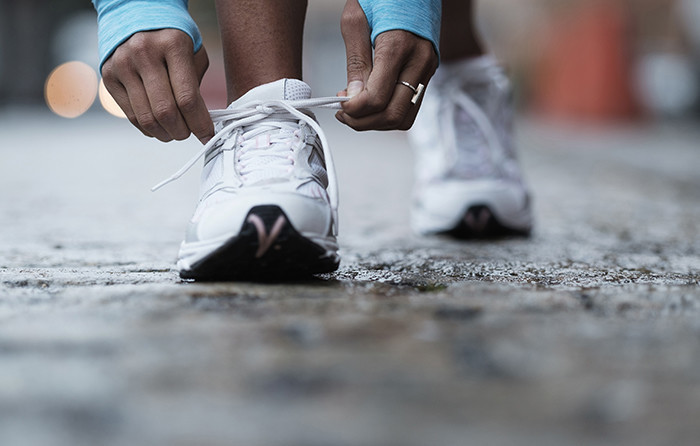Be Kind To Your Joints Better Homes & Gardens
Osteoarthritis in your feet can upend your entire life—making it impossible to exercise, walk, even stand.
Having symptoms of osteoarthritis (OA) anywhere in your body can get in the way of everyday activities, but OA in your feet can literally keep you from moving. The condition occurs when the cartilage that serves as padding between your joints starts to wear out, which leads to pain and inflammation in the joint. This progressive condition is the most common form of arthritis: 30.8 million Americans suffer from osteoarthritis, and among those age 45 and over, it's more prevalent among women.
If you've been feeling pain while walking, standing, or doing any other activity that puts weight on your feet, you might already suspect you have osteoarthritis. "Early on, the pain is related to physical activities or prolonged standing or walking," explains Dr. Jonathan Kaplan, a foot and ankle surgeon with Hoag Orthopedic Institute in Irvine, California. "You might have pain where the shoe squeezes, or the foot rubs against shoes. As it progresses, your foot will hurt more frequently, with shorter distances, regardless of what shoes you're wearing, or even if you're barefoot." Two of the most common spots for osteoarthritis to develop, Dr. Kaplan explains, are in the big toe and the middle of foot.
Dr. Kaplan stresses the importance of seeing your doctor for a full diagnosis. "You'll need at least a clinical exam, and x-rays to look at the bones and the joints," he says. "There are many tendons, bones, and ligaments in a small area, and they can all cause a number of different problems."
If you do have osteoarthritis in your foot or feet, there are steps you can take at home to reduce pain, Dr. Kaplan says. Here are some of the most helpful strategies:
Go shoe shopping. If your shoes are hurting you, it's time for new shoes (whether you have OA or not). "Look for whatever is most comfortable," Dr. Kaplan says. "The type of shoe you'll need depends on the location of the osteoarthritis, but generally look for something more supportive, with a better insole, that's higher and wider on the sides so it's not squeezing your foot as much." And don't feel you're doomed to clunky orthopedic-looking footwear. "These days, more sneakers have better arch, as do more boots and activewear—we're even seeing more heels with a bit of an arch," Dr. Kaplan notes.

Or shop for orthotics. These shoe inserts help support the arch of the foot, meaning your muscles and tendons have to do less work. "Wearing an arch takes strain off the bones and areas that have arthritis," Dr. Kaplan says.
Give yourself a foot rub (or get someone to do it for you). "Massage is a great option for patients with inflammation in the foot—and it's not exclusive to arthritis," Dr. Kaplan says (translation: foot rubs for everyone!). "The muscles in the feet are big, and they might spasm and tighten, which leads to a vicious cycle of pain. Massage can help." Dr. Kaplan points out that the bulk of muscles in the feet are on the insides and bottom—not the top of the foot—so focus your energy and pressure there. "Massage along the heel, in longitudinal patterns and circular motions, to loosen and soften those muscles on the bottom and inside of foot." Or take a shortcut: Stand and roll a tennis ball or frozen water bottle under your foot, using as much pressure as feels good to you. Better yet: trade foot rubs with your partner or best friend.
Try an OTC anti-inflammatory medication. With osteoarthritis, as with most anything, says Dr. Kaplan, medical experts want to exhaust all non-operative treatments first to find the treatment that works for you. "We recommend anti-inflammatories as needed," he says. An OTC medicine like Advil can help relieve minor pains from arthritis, and even comes with an easy-open arthritis cap, helpful if you've got OA in your hands, too.
Switch to low- or no-impact activities. "Try walking or swimming in a pool," Dr. Kaplan suggests. "Water significantly decreases body weight, which decreases force on our feet." (You can also try these pool exercises that aren't swimming.) Other top picks: Cycling on a stationary bicycle or recumbent bike (which also protects backs, hips, and knees), and using an elliptical rather than the treadmill or going for a run.
Consider acupuncture. Dr. Kaplan has found that acupuncture can help some people suffering from osteoarthritis. "There is no excellent perfect data that supports it," he acknowledges. "But it's not very invasive, it's unlikely to cause harm, and it may relax the body and muscles. If it works for you, that's great." The Arthritis Foundation similarly notes that studies have only found limited benefits and that more research can be done, but if you're interested in trying it, ask your doctor to recommend a certified provider.
Lose weight. For some, this may be bigger than a simple "lifestyle tweak"—but it can be incredibly helpful in reducing the pain from osteoarthritis. The Arthritis Foundation notes that one study found that losing 10 pounds can relieve 40 pounds of pressure from your knees. "Our feet are our foundation for our body," Dr. Kaplan says. "The more weight on your foundation, the harder your feet work. So losing weight or maintaining a steady weight is important." Your doctor can help you with developing a healthy weight loss program so you can get back on your feet — literally.
Get more great health and wellness stories at BHG.com/Strive
Be Kind To Your Joints Better Homes & Gardens
Source: https://www.bhg.com/featured/StriveTipsForManagingArthritisInYourFeet
Posted by: morristwounds.blogspot.com

0 Response to "Be Kind To Your Joints Better Homes & Gardens"
Post a Comment